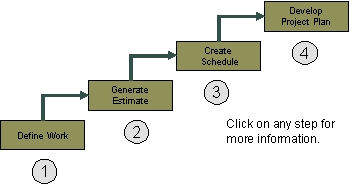
Detailed Project Planning defines the project activities and describes how the activities will be accomplished. The purpose of project planning is to define each task, estimate the time and resources required, and provide a framework for management review and control. The project planning activities and goals include defining:
- The specific work to be performed and goals that define the project
- Estimates to be documented for planning, tracking, and controlling the project
- Commitments that are planned, and agreed to by stakeholders
- Project alternatives, assumptions, constraints and risks.
- The Project Schedule

Policy and Standards
All projects should:
- Use the Project Charter (requirements) as the basis for planning the project,
- Negotiate the project's commitments between the project manager and all other managers involved in the project,
- Negotiate the involvement of subject matter expert(s) with representatives of those groups and document those negotiations,
- Negotiate the involvement of subject matter expert(s) with representatives of those groups and document those negotiations,
- Document the project's size estimates, as well as estimates of other product characteristics, effort and cost estimates, schedules, and other commitments,
- Ensure review of the estimates and commitments by all affected groups, such as engineering, estimating, system engineering, system test, standards compliance, configuration management, contract management, and documentation support,
- Ensure review by senior management of all project commitments made to individuals and groups external to the organization,
- Use the project's documented estimates and commitments to plan and manage the project,
- Plan and document the project's activities and commitments in the project's development plan,
- Manage and control the project's development plan,
- Document the project's defined process by selecting and tailoring one of the organization's Standard Project Processes, and
- Document approved deviations from the organization's Standard Project Process.
Applicable Standards:
Will vary according to organizational standards and requirements.

Responsibilities
The responsibilities for Detailed Project Planning are summarized below:
- Project Managers are responsible for developing the project plan and all supporting documentation.
- The organization is responsible for developing internal procedures to ensure that the planning process is completed conistently. Projects undertaken must be well thought out, supported by a key stakeholder's goals, and include processes that allow the project to be tracked and controlled until completion.
- The organization is responsible for ensuring that there are adequate resources assigned to manage the project. Management costs should not be rolled into overhead costs. Managment is a full time job for most projects. It is an activity which requires training, experience, focus and appropriate managment and communication skills.

Templates:
![]() Software Estimates Template
Buy Now
Software Estimates Template
Buy Now
![]() Software Development Plan
Buy Now
Software Development Plan
Buy Now
Checklists:
![]() Schedule Review Checklist
Buy Now
Schedule Review Checklist
Buy Now
![]() Communications Management Planning Matrix
Communications Management Planning Matrix
If you would like to order a full set of the Project Templates and Checklists
click here
Buy Now